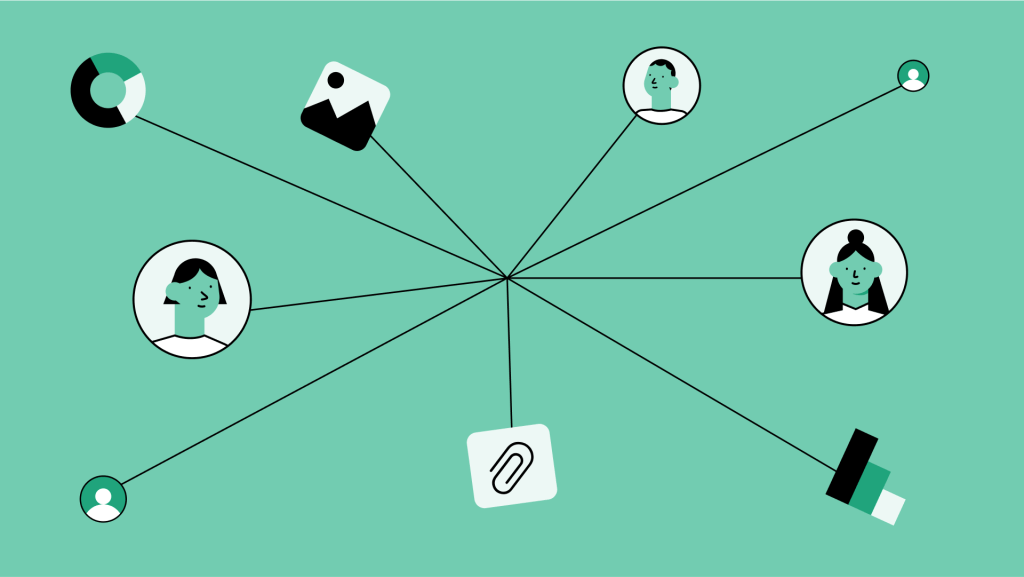How to Break Down Communication Silos in the Workplace

Communication silos prevent teams from aligning on progress and goals. Worse still, they may become increasingly common due to a rise in remote working and specialist roles.
On the flip side, effective workplace communication helps foster innovation and employee engagement. But how do you recognize communication silos and what are the practical steps to remove them?
This article breaks down relatable examples of workplace silos, how they impact teams, and actions you can take to prevent them.
What Are Communication Silos?
Communication silos are groups of people or information that operate separately from other parts of an organization. They often form when teams don’t have the channels, processes, or willingness to share valuable data such as resources, updates, or feedback.

Examples of Communication Silos
First, let’s look at some common types of communication silos in the workplace.
-
•
Departmental silos: Two or more departments aren’t communicating resources, goals, and updates effectively. They may not have established communication platforms, regular check-ins, or collaborative workflows.
-
•
Technological silos: Essential resources and tools are technologically inaccessible to specific groups. For example, company policy documents may only be viewable by HR employees, and customer records might be accessed by sales, but not by marketing teams.
-
•
Hierarchical silos: Communication doesn’t flow transparently between a company’s seniority levels. For instance, strategic business changes might be kept from employees, and frontline staff may not be able to offer feedback to managers.
Next, here are two scenarios illustrating business communication silos.
-
A marketing team runs a lead generation campaign and doesn’t share its progress or lead contact details with the sales department. A more efficient approach is to immediately feed leads to sales reps, so they can pitch and land new deals.
-
Two project teams in a web design department might are not sharing essential design frameworks or lessons. Conversely, establishing regular team-wide check-ins and collaborative workflows can help create faster, higher-quality design work.

How Do Communication Silos Impact a Business?
Communication silos in the workplace can severely damage your bottom line and innovation potential. Here are the top risks to watch out for.
-
•
Lower productivity: Siloed teams are less productive due to a lack of timely updates, clear expectations and key performance indicators (KPIs), and useful data and technical tools.
-
•
Decreased profitability: Departmental, hierarchical, and technological silos lead to duplicated work, slower progress, and missed deadlines. This can result in extra labor costs and decreased revenue.
-
•
Miscommunication and conflict: Communicating infrequently or ineffectively can lead to misunderstandings and potential conflicts among siloed teams.
-
•
Less engaged employees: Little collaboration alongside miscommunication and inefficiency can decrease employee engagement and motivation.
-
•
Toxic company culture: Siloed departments and hierarchies can contribute to rivalries and resentment between workers, creating a toxic workplace culture.
-
•
Decreased innovation: Failing to communicate goals and share resources and learnings limits overall business innovation.
-
•
Lower customer satisfaction: Miscommunication and siloed technology use may lead to poorer-quality services, lowering customer satisfaction.
How to Overcome Communication Silos
Overcoming communication silos helps teams—like marketing, product, and sales—align on goals, projects, and customer needs. In turn, this enhances productivity and client satisfaction.
Here are some practical steps to remove silos.
1. Establish team-wide communication channels and workflows
Knowing where, when, and how to communicate with other teams helps remove silos.
First, establish team-wide collaboration channels such as:
-
•
Workplace communication apps: Group messaging apps like Spike let you customize chats and channels to maximize collaboration. For example, create cross-team channels, have quick video calls, and preview important documents.
-
•
Project and task tracking: Let teams track projects and tasks in one place to enhance productivity and avoid miscommunication. Task tracking tools let collaborators check task status, receive task notifications, and add notes.
-
•
Check-ins and all-hands meetings: Establish regular meetings to facilitate cross-department and cross-hierarchy updates. For example, monthly company-wide calls and weekly account catch-ups help coworkers align on goals and progress.
In addition, document clear collaboration workflows including:
-
•
Management announcements: Clarify how and when the leadership team communicates updates. For instance, some announcements might be sent to all employees via a chat app, whereas others may trickle down from managers to team members in weekly meetings.
-
•
Project and client updates: Outline how teams communicate updates when collaborating on a project or client account. This could include task software status updates, weekly status emails, and ad-hoc problem-solving chats.
-
•
Feedback loops: Describe how teams and individuals provide feedback on ongoing work. For example, they might add real-time comments to collaborative documents, respond to live polls in a company-wide channel, or submit anonymous survey responses to HR.
2. Design physical spaces that foster collaboration
Well-designed physical workspaces make collaboration easier and more effective. For instance, offer open-plan seating for on-site and hybrid teams, and sit collaborators together—like sales and marketing teams, or cross-departmental project teams.
In addition, encourage staff members to take regular breaks and offer a designated breakout space where they can socialize and build relationships.
3. Provide team collaboration training
Collaboration training offers team members communication skills and strategies, helping reduce silos. You can buy an out-of-the-box digital training product, hire a one-off consultant, or ask an HR manager to facilitate a training day.
As an illustration, you could outline:
-
•
The Eisenhower prioritization matrix ranks tasks according to importance and urgency. Prioritizing the topmost urgent and important tasks makes collaboration more efficient.
-
•
Conflict prevention and resolution strategies. For example, teach employees to listen actively, state needs and opinions calmly, and reach compromises.
-
•
Cross-departmental exercises. Provide real-world project scenarios requiring different skill sets and specializations, and coach team members on planning, delegating, and executing collaborative tasks.
Wrapping Up: Prevent Communication Silos with Spike
Communication silos appear when teams lack the tools and processes to share information effectively. Left unsolved, they can limit productivity and innovation, and lower employee engagement.
However, you can reduce silos by establishing team-wide communication channels and workflows, providing collaboration training, and designing open-plan onsite workplaces.
A communication platform like Spike lets you create cross-team channels, hold conference calls, share files, track tasks, and organize your emails and chat messages in one place. Plus, Spike’s generative AI helps teams communicate faster and more effectively, preventing silos.




